Work and Organizations Assignment: Exploring Organizational Dynamics
VerifiedAdded on 2021/06/18
|10
|2401
|67
Homework Assignment
AI Summary
This assignment provides a detailed analysis of key concepts in work and organizations. It addresses questions on high-performing organizations, the importance of selecting the right people, organizational citizenship behavior, and creating engaging work environments. The assignment also explores topics such as critical thinking, organizational behavior models, the contingency perspective, and the impact of the Hawthorne effect. Furthermore, it examines the relationship between job satisfaction and productivity, the impact of manager-employee conflicts, the effectiveness of performance appraisal systems, and factors influencing employee satisfaction. The document also delves into self-development, perception, and effective decision-making strategies within organizations, providing a comprehensive overview of organizational dynamics, leadership, and employee behavior.
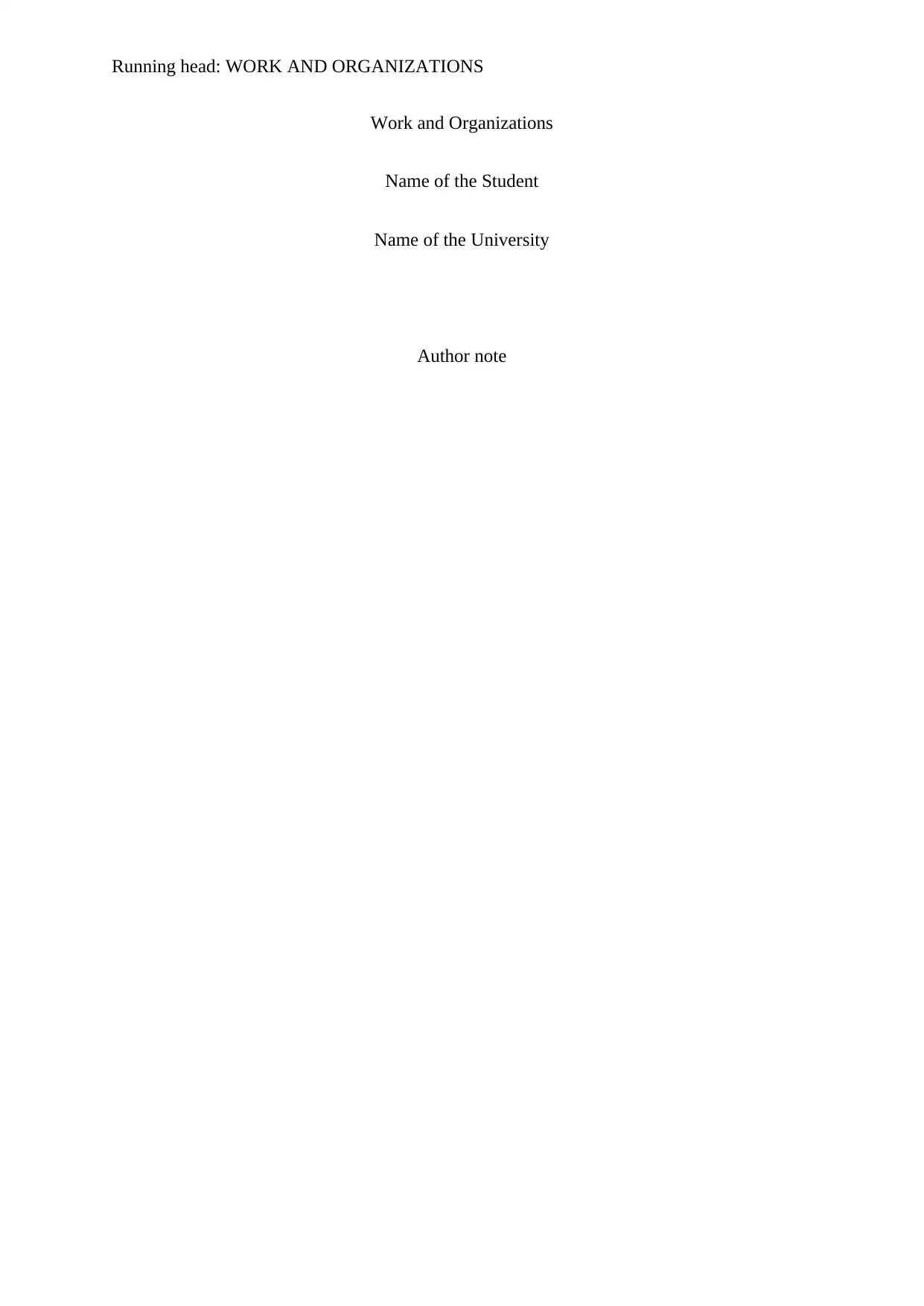
Running head: WORK AND ORGANIZATIONS
Work and Organizations
Name of the Student
Name of the University
Author note
Work and Organizations
Name of the Student
Name of the University
Author note
Paraphrase This Document
Need a fresh take? Get an instant paraphrase of this document with our AI Paraphraser
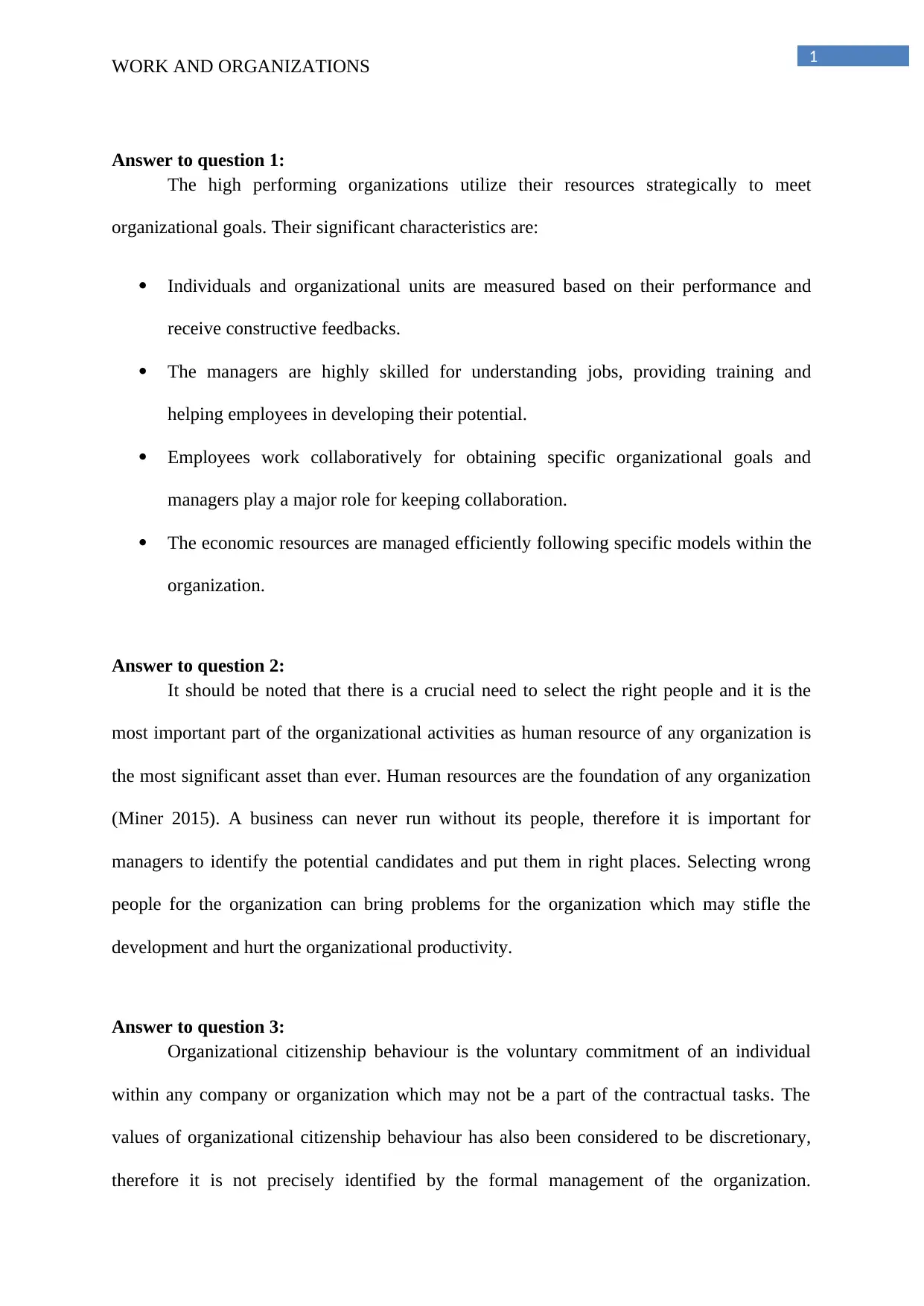
1
WORK AND ORGANIZATIONS
Answer to question 1:
The high performing organizations utilize their resources strategically to meet
organizational goals. Their significant characteristics are:
Individuals and organizational units are measured based on their performance and
receive constructive feedbacks.
The managers are highly skilled for understanding jobs, providing training and
helping employees in developing their potential.
Employees work collaboratively for obtaining specific organizational goals and
managers play a major role for keeping collaboration.
The economic resources are managed efficiently following specific models within the
organization.
Answer to question 2:
It should be noted that there is a crucial need to select the right people and it is the
most important part of the organizational activities as human resource of any organization is
the most significant asset than ever. Human resources are the foundation of any organization
(Miner 2015). A business can never run without its people, therefore it is important for
managers to identify the potential candidates and put them in right places. Selecting wrong
people for the organization can bring problems for the organization which may stifle the
development and hurt the organizational productivity.
Answer to question 3:
Organizational citizenship behaviour is the voluntary commitment of an individual
within any company or organization which may not be a part of the contractual tasks. The
values of organizational citizenship behaviour has also been considered to be discretionary,
therefore it is not precisely identified by the formal management of the organization.
WORK AND ORGANIZATIONS
Answer to question 1:
The high performing organizations utilize their resources strategically to meet
organizational goals. Their significant characteristics are:
Individuals and organizational units are measured based on their performance and
receive constructive feedbacks.
The managers are highly skilled for understanding jobs, providing training and
helping employees in developing their potential.
Employees work collaboratively for obtaining specific organizational goals and
managers play a major role for keeping collaboration.
The economic resources are managed efficiently following specific models within the
organization.
Answer to question 2:
It should be noted that there is a crucial need to select the right people and it is the
most important part of the organizational activities as human resource of any organization is
the most significant asset than ever. Human resources are the foundation of any organization
(Miner 2015). A business can never run without its people, therefore it is important for
managers to identify the potential candidates and put them in right places. Selecting wrong
people for the organization can bring problems for the organization which may stifle the
development and hurt the organizational productivity.
Answer to question 3:
Organizational citizenship behaviour is the voluntary commitment of an individual
within any company or organization which may not be a part of the contractual tasks. The
values of organizational citizenship behaviour has also been considered to be discretionary,
therefore it is not precisely identified by the formal management of the organization.
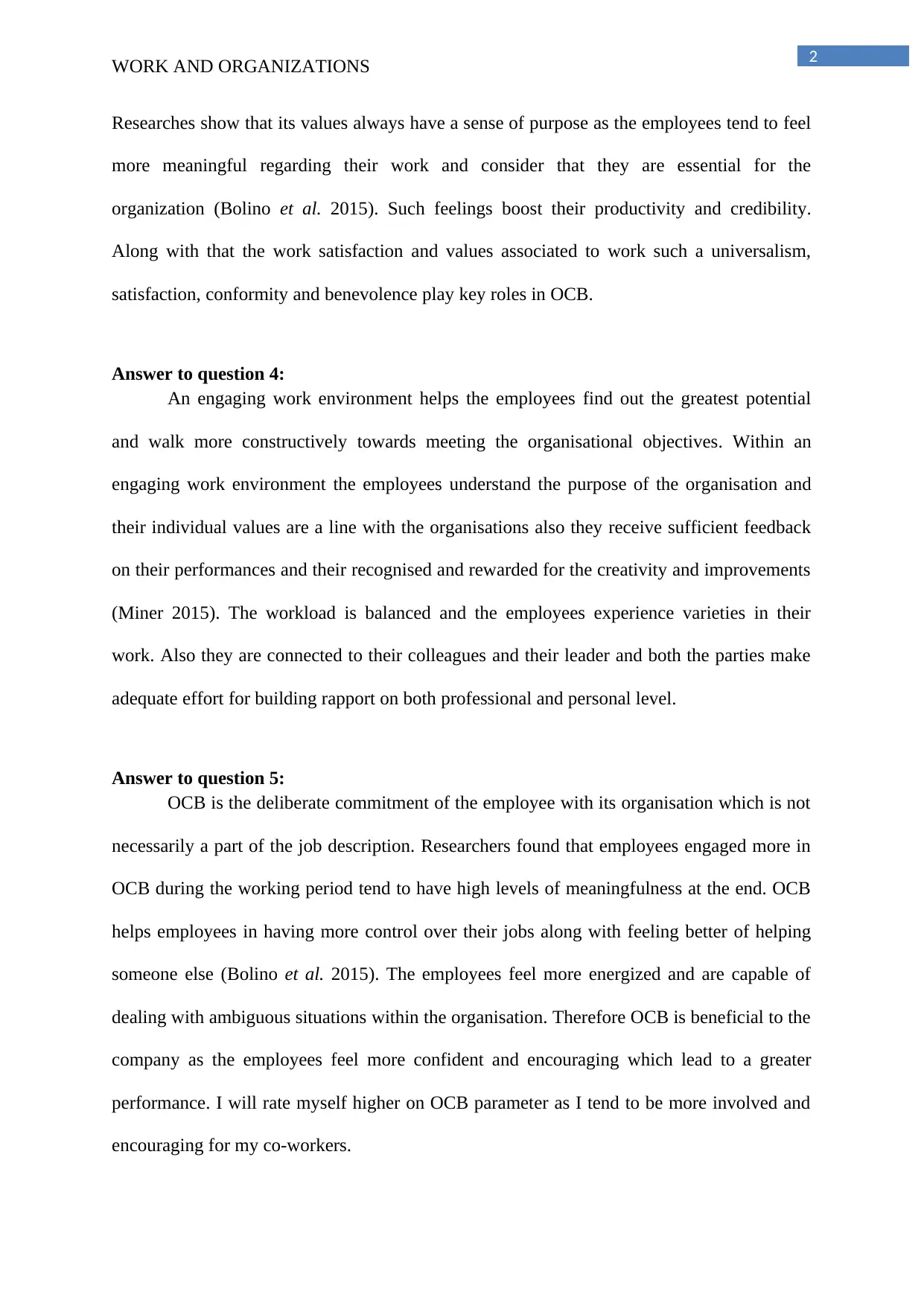
2
WORK AND ORGANIZATIONS
Researches show that its values always have a sense of purpose as the employees tend to feel
more meaningful regarding their work and consider that they are essential for the
organization (Bolino et al. 2015). Such feelings boost their productivity and credibility.
Along with that the work satisfaction and values associated to work such a universalism,
satisfaction, conformity and benevolence play key roles in OCB.
Answer to question 4:
An engaging work environment helps the employees find out the greatest potential
and walk more constructively towards meeting the organisational objectives. Within an
engaging work environment the employees understand the purpose of the organisation and
their individual values are a line with the organisations also they receive sufficient feedback
on their performances and their recognised and rewarded for the creativity and improvements
(Miner 2015). The workload is balanced and the employees experience varieties in their
work. Also they are connected to their colleagues and their leader and both the parties make
adequate effort for building rapport on both professional and personal level.
Answer to question 5:
OCB is the deliberate commitment of the employee with its organisation which is not
necessarily a part of the job description. Researchers found that employees engaged more in
OCB during the working period tend to have high levels of meaningfulness at the end. OCB
helps employees in having more control over their jobs along with feeling better of helping
someone else (Bolino et al. 2015). The employees feel more energized and are capable of
dealing with ambiguous situations within the organisation. Therefore OCB is beneficial to the
company as the employees feel more confident and encouraging which lead to a greater
performance. I will rate myself higher on OCB parameter as I tend to be more involved and
encouraging for my co-workers.
WORK AND ORGANIZATIONS
Researches show that its values always have a sense of purpose as the employees tend to feel
more meaningful regarding their work and consider that they are essential for the
organization (Bolino et al. 2015). Such feelings boost their productivity and credibility.
Along with that the work satisfaction and values associated to work such a universalism,
satisfaction, conformity and benevolence play key roles in OCB.
Answer to question 4:
An engaging work environment helps the employees find out the greatest potential
and walk more constructively towards meeting the organisational objectives. Within an
engaging work environment the employees understand the purpose of the organisation and
their individual values are a line with the organisations also they receive sufficient feedback
on their performances and their recognised and rewarded for the creativity and improvements
(Miner 2015). The workload is balanced and the employees experience varieties in their
work. Also they are connected to their colleagues and their leader and both the parties make
adequate effort for building rapport on both professional and personal level.
Answer to question 5:
OCB is the deliberate commitment of the employee with its organisation which is not
necessarily a part of the job description. Researchers found that employees engaged more in
OCB during the working period tend to have high levels of meaningfulness at the end. OCB
helps employees in having more control over their jobs along with feeling better of helping
someone else (Bolino et al. 2015). The employees feel more energized and are capable of
dealing with ambiguous situations within the organisation. Therefore OCB is beneficial to the
company as the employees feel more confident and encouraging which lead to a greater
performance. I will rate myself higher on OCB parameter as I tend to be more involved and
encouraging for my co-workers.
⊘ This is a preview!⊘
Do you want full access?
Subscribe today to unlock all pages.

Trusted by 1+ million students worldwide
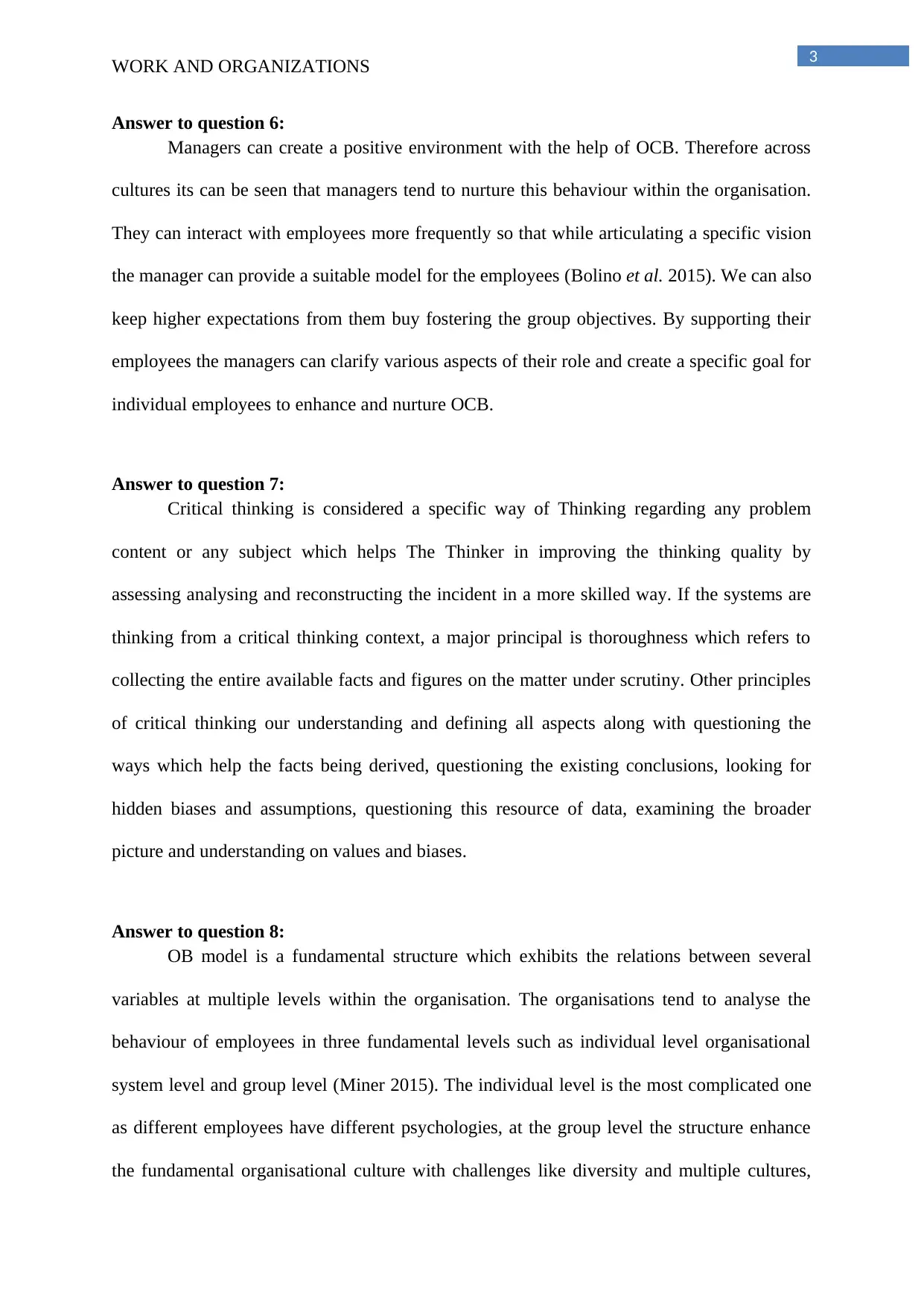
3
WORK AND ORGANIZATIONS
Answer to question 6:
Managers can create a positive environment with the help of OCB. Therefore across
cultures its can be seen that managers tend to nurture this behaviour within the organisation.
They can interact with employees more frequently so that while articulating a specific vision
the manager can provide a suitable model for the employees (Bolino et al. 2015). We can also
keep higher expectations from them buy fostering the group objectives. By supporting their
employees the managers can clarify various aspects of their role and create a specific goal for
individual employees to enhance and nurture OCB.
Answer to question 7:
Critical thinking is considered a specific way of Thinking regarding any problem
content or any subject which helps The Thinker in improving the thinking quality by
assessing analysing and reconstructing the incident in a more skilled way. If the systems are
thinking from a critical thinking context, a major principal is thoroughness which refers to
collecting the entire available facts and figures on the matter under scrutiny. Other principles
of critical thinking our understanding and defining all aspects along with questioning the
ways which help the facts being derived, questioning the existing conclusions, looking for
hidden biases and assumptions, questioning this resource of data, examining the broader
picture and understanding on values and biases.
Answer to question 8:
OB model is a fundamental structure which exhibits the relations between several
variables at multiple levels within the organisation. The organisations tend to analyse the
behaviour of employees in three fundamental levels such as individual level organisational
system level and group level (Miner 2015). The individual level is the most complicated one
as different employees have different psychologies, at the group level the structure enhance
the fundamental organisational culture with challenges like diversity and multiple cultures,
WORK AND ORGANIZATIONS
Answer to question 6:
Managers can create a positive environment with the help of OCB. Therefore across
cultures its can be seen that managers tend to nurture this behaviour within the organisation.
They can interact with employees more frequently so that while articulating a specific vision
the manager can provide a suitable model for the employees (Bolino et al. 2015). We can also
keep higher expectations from them buy fostering the group objectives. By supporting their
employees the managers can clarify various aspects of their role and create a specific goal for
individual employees to enhance and nurture OCB.
Answer to question 7:
Critical thinking is considered a specific way of Thinking regarding any problem
content or any subject which helps The Thinker in improving the thinking quality by
assessing analysing and reconstructing the incident in a more skilled way. If the systems are
thinking from a critical thinking context, a major principal is thoroughness which refers to
collecting the entire available facts and figures on the matter under scrutiny. Other principles
of critical thinking our understanding and defining all aspects along with questioning the
ways which help the facts being derived, questioning the existing conclusions, looking for
hidden biases and assumptions, questioning this resource of data, examining the broader
picture and understanding on values and biases.
Answer to question 8:
OB model is a fundamental structure which exhibits the relations between several
variables at multiple levels within the organisation. The organisations tend to analyse the
behaviour of employees in three fundamental levels such as individual level organisational
system level and group level (Miner 2015). The individual level is the most complicated one
as different employees have different psychologies, at the group level the structure enhance
the fundamental organisational culture with challenges like diversity and multiple cultures,
Paraphrase This Document
Need a fresh take? Get an instant paraphrase of this document with our AI Paraphraser
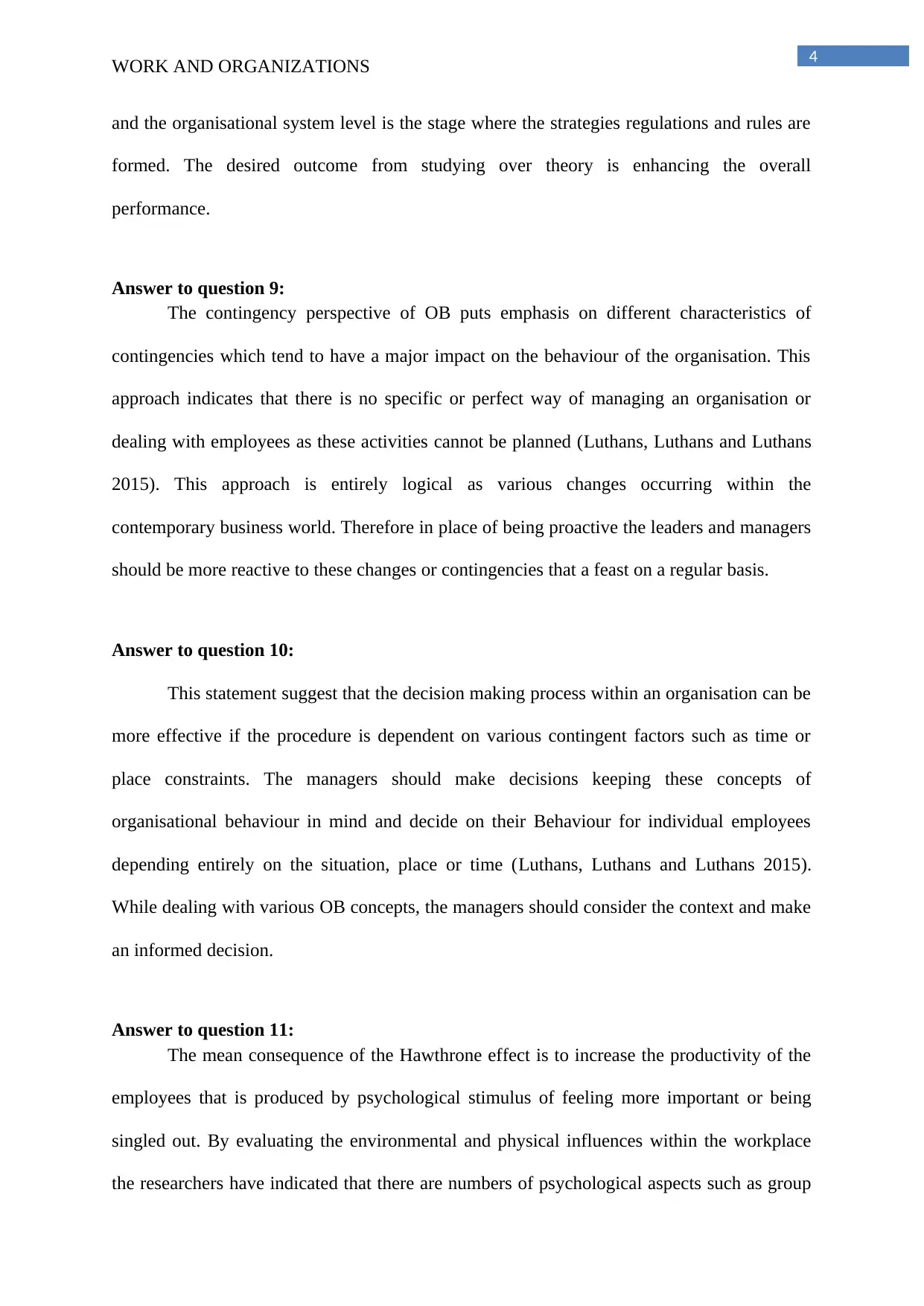
4
WORK AND ORGANIZATIONS
and the organisational system level is the stage where the strategies regulations and rules are
formed. The desired outcome from studying over theory is enhancing the overall
performance.
Answer to question 9:
The contingency perspective of OB puts emphasis on different characteristics of
contingencies which tend to have a major impact on the behaviour of the organisation. This
approach indicates that there is no specific or perfect way of managing an organisation or
dealing with employees as these activities cannot be planned (Luthans, Luthans and Luthans
2015). This approach is entirely logical as various changes occurring within the
contemporary business world. Therefore in place of being proactive the leaders and managers
should be more reactive to these changes or contingencies that a feast on a regular basis.
Answer to question 10:
This statement suggest that the decision making process within an organisation can be
more effective if the procedure is dependent on various contingent factors such as time or
place constraints. The managers should make decisions keeping these concepts of
organisational behaviour in mind and decide on their Behaviour for individual employees
depending entirely on the situation, place or time (Luthans, Luthans and Luthans 2015).
While dealing with various OB concepts, the managers should consider the context and make
an informed decision.
Answer to question 11:
The mean consequence of the Hawthrone effect is to increase the productivity of the
employees that is produced by psychological stimulus of feeling more important or being
singled out. By evaluating the environmental and physical influences within the workplace
the researchers have indicated that there are numbers of psychological aspects such as group
WORK AND ORGANIZATIONS
and the organisational system level is the stage where the strategies regulations and rules are
formed. The desired outcome from studying over theory is enhancing the overall
performance.
Answer to question 9:
The contingency perspective of OB puts emphasis on different characteristics of
contingencies which tend to have a major impact on the behaviour of the organisation. This
approach indicates that there is no specific or perfect way of managing an organisation or
dealing with employees as these activities cannot be planned (Luthans, Luthans and Luthans
2015). This approach is entirely logical as various changes occurring within the
contemporary business world. Therefore in place of being proactive the leaders and managers
should be more reactive to these changes or contingencies that a feast on a regular basis.
Answer to question 10:
This statement suggest that the decision making process within an organisation can be
more effective if the procedure is dependent on various contingent factors such as time or
place constraints. The managers should make decisions keeping these concepts of
organisational behaviour in mind and decide on their Behaviour for individual employees
depending entirely on the situation, place or time (Luthans, Luthans and Luthans 2015).
While dealing with various OB concepts, the managers should consider the context and make
an informed decision.
Answer to question 11:
The mean consequence of the Hawthrone effect is to increase the productivity of the
employees that is produced by psychological stimulus of feeling more important or being
singled out. By evaluating the environmental and physical influences within the workplace
the researchers have indicated that there are numbers of psychological aspects such as group
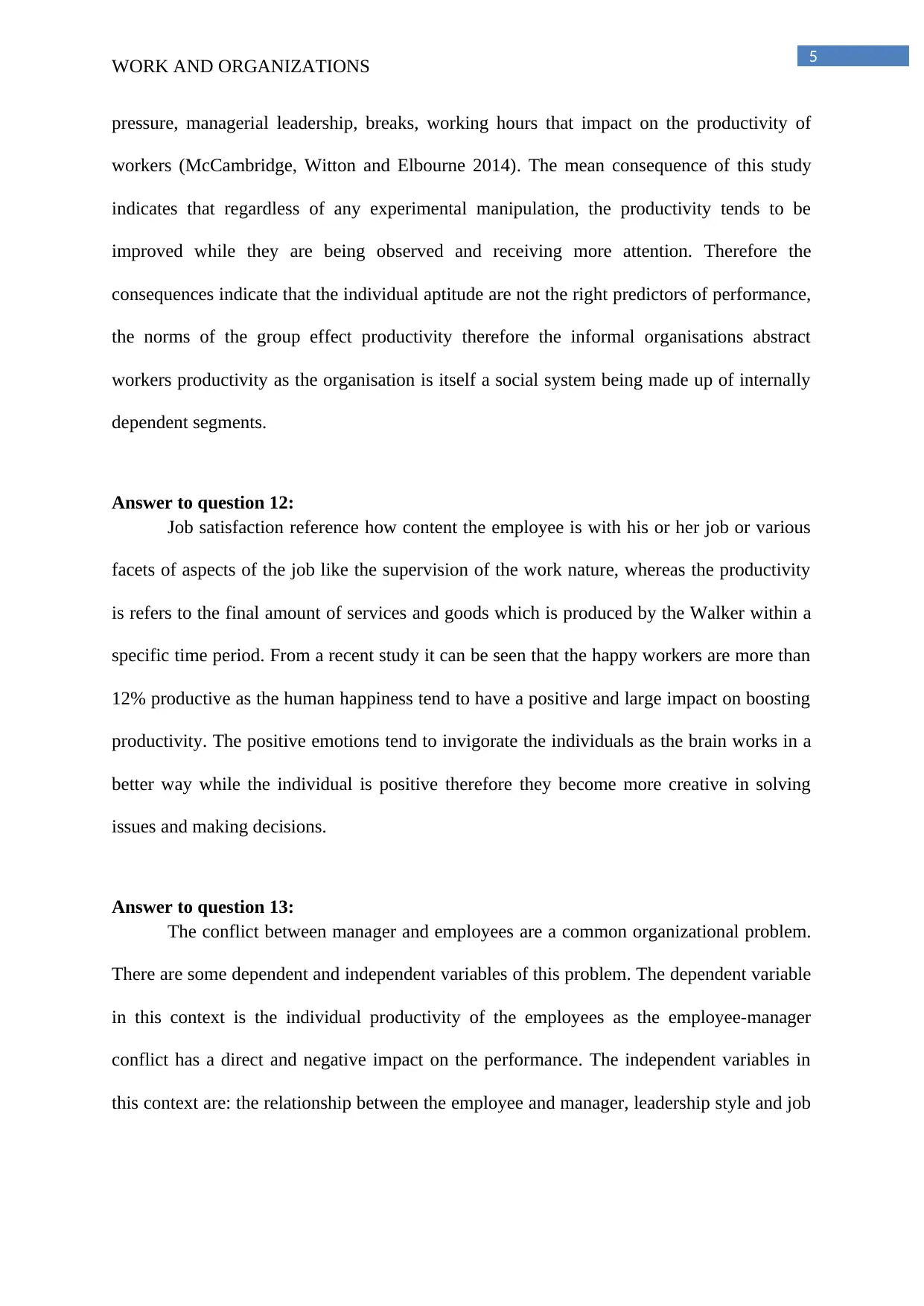
5
WORK AND ORGANIZATIONS
pressure, managerial leadership, breaks, working hours that impact on the productivity of
workers (McCambridge, Witton and Elbourne 2014). The mean consequence of this study
indicates that regardless of any experimental manipulation, the productivity tends to be
improved while they are being observed and receiving more attention. Therefore the
consequences indicate that the individual aptitude are not the right predictors of performance,
the norms of the group effect productivity therefore the informal organisations abstract
workers productivity as the organisation is itself a social system being made up of internally
dependent segments.
Answer to question 12:
Job satisfaction reference how content the employee is with his or her job or various
facets of aspects of the job like the supervision of the work nature, whereas the productivity
is refers to the final amount of services and goods which is produced by the Walker within a
specific time period. From a recent study it can be seen that the happy workers are more than
12% productive as the human happiness tend to have a positive and large impact on boosting
productivity. The positive emotions tend to invigorate the individuals as the brain works in a
better way while the individual is positive therefore they become more creative in solving
issues and making decisions.
Answer to question 13:
The conflict between manager and employees are a common organizational problem.
There are some dependent and independent variables of this problem. The dependent variable
in this context is the individual productivity of the employees as the employee-manager
conflict has a direct and negative impact on the performance. The independent variables in
this context are: the relationship between the employee and manager, leadership style and job
WORK AND ORGANIZATIONS
pressure, managerial leadership, breaks, working hours that impact on the productivity of
workers (McCambridge, Witton and Elbourne 2014). The mean consequence of this study
indicates that regardless of any experimental manipulation, the productivity tends to be
improved while they are being observed and receiving more attention. Therefore the
consequences indicate that the individual aptitude are not the right predictors of performance,
the norms of the group effect productivity therefore the informal organisations abstract
workers productivity as the organisation is itself a social system being made up of internally
dependent segments.
Answer to question 12:
Job satisfaction reference how content the employee is with his or her job or various
facets of aspects of the job like the supervision of the work nature, whereas the productivity
is refers to the final amount of services and goods which is produced by the Walker within a
specific time period. From a recent study it can be seen that the happy workers are more than
12% productive as the human happiness tend to have a positive and large impact on boosting
productivity. The positive emotions tend to invigorate the individuals as the brain works in a
better way while the individual is positive therefore they become more creative in solving
issues and making decisions.
Answer to question 13:
The conflict between manager and employees are a common organizational problem.
There are some dependent and independent variables of this problem. The dependent variable
in this context is the individual productivity of the employees as the employee-manager
conflict has a direct and negative impact on the performance. The independent variables in
this context are: the relationship between the employee and manager, leadership style and job
⊘ This is a preview!⊘
Do you want full access?
Subscribe today to unlock all pages.

Trusted by 1+ million students worldwide
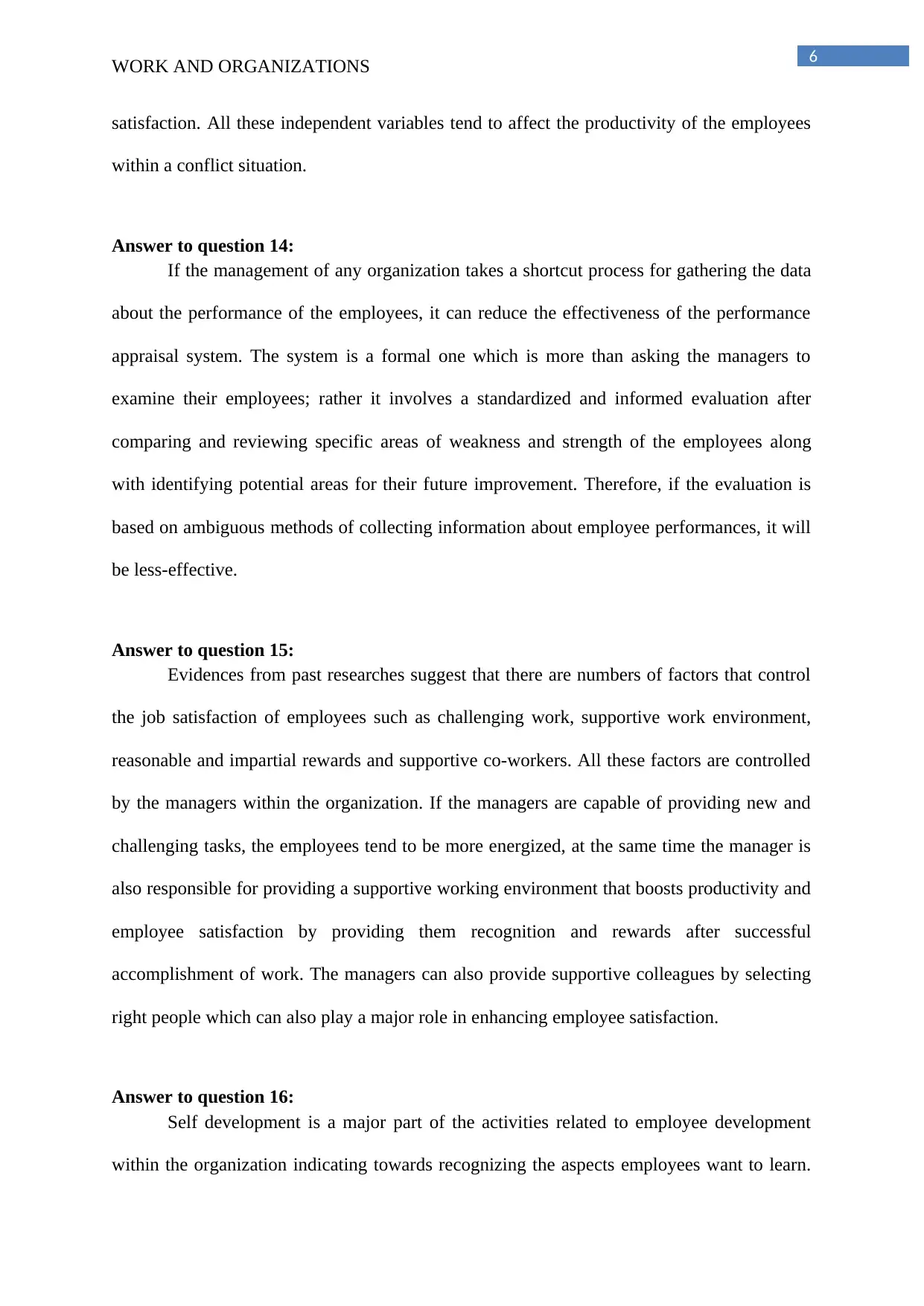
6
WORK AND ORGANIZATIONS
satisfaction. All these independent variables tend to affect the productivity of the employees
within a conflict situation.
Answer to question 14:
If the management of any organization takes a shortcut process for gathering the data
about the performance of the employees, it can reduce the effectiveness of the performance
appraisal system. The system is a formal one which is more than asking the managers to
examine their employees; rather it involves a standardized and informed evaluation after
comparing and reviewing specific areas of weakness and strength of the employees along
with identifying potential areas for their future improvement. Therefore, if the evaluation is
based on ambiguous methods of collecting information about employee performances, it will
be less-effective.
Answer to question 15:
Evidences from past researches suggest that there are numbers of factors that control
the job satisfaction of employees such as challenging work, supportive work environment,
reasonable and impartial rewards and supportive co-workers. All these factors are controlled
by the managers within the organization. If the managers are capable of providing new and
challenging tasks, the employees tend to be more energized, at the same time the manager is
also responsible for providing a supportive working environment that boosts productivity and
employee satisfaction by providing them recognition and rewards after successful
accomplishment of work. The managers can also provide supportive colleagues by selecting
right people which can also play a major role in enhancing employee satisfaction.
Answer to question 16:
Self development is a major part of the activities related to employee development
within the organization indicating towards recognizing the aspects employees want to learn.
WORK AND ORGANIZATIONS
satisfaction. All these independent variables tend to affect the productivity of the employees
within a conflict situation.
Answer to question 14:
If the management of any organization takes a shortcut process for gathering the data
about the performance of the employees, it can reduce the effectiveness of the performance
appraisal system. The system is a formal one which is more than asking the managers to
examine their employees; rather it involves a standardized and informed evaluation after
comparing and reviewing specific areas of weakness and strength of the employees along
with identifying potential areas for their future improvement. Therefore, if the evaluation is
based on ambiguous methods of collecting information about employee performances, it will
be less-effective.
Answer to question 15:
Evidences from past researches suggest that there are numbers of factors that control
the job satisfaction of employees such as challenging work, supportive work environment,
reasonable and impartial rewards and supportive co-workers. All these factors are controlled
by the managers within the organization. If the managers are capable of providing new and
challenging tasks, the employees tend to be more energized, at the same time the manager is
also responsible for providing a supportive working environment that boosts productivity and
employee satisfaction by providing them recognition and rewards after successful
accomplishment of work. The managers can also provide supportive colleagues by selecting
right people which can also play a major role in enhancing employee satisfaction.
Answer to question 16:
Self development is a major part of the activities related to employee development
within the organization indicating towards recognizing the aspects employees want to learn.
Paraphrase This Document
Need a fresh take? Get an instant paraphrase of this document with our AI Paraphraser
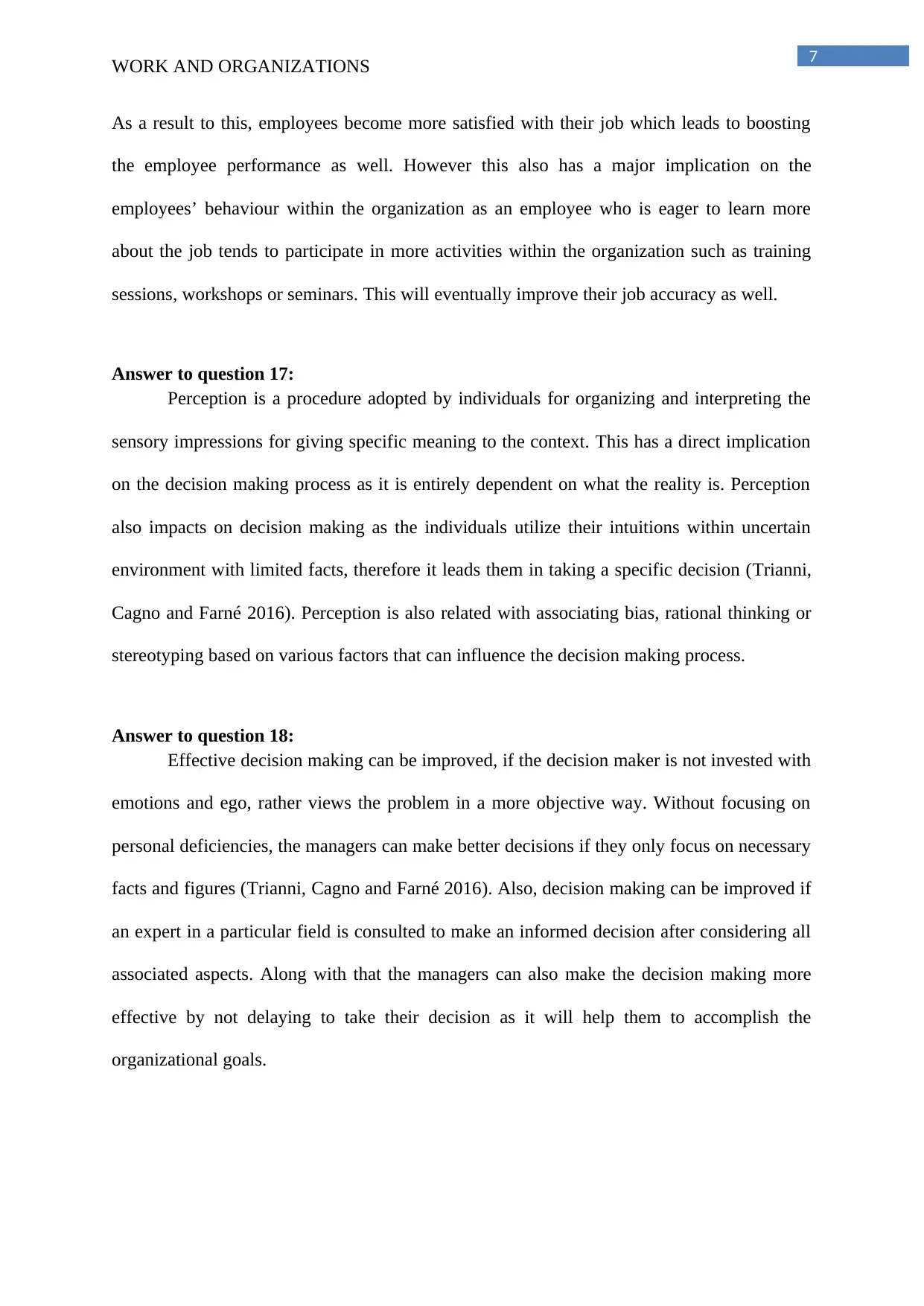
7
WORK AND ORGANIZATIONS
As a result to this, employees become more satisfied with their job which leads to boosting
the employee performance as well. However this also has a major implication on the
employees’ behaviour within the organization as an employee who is eager to learn more
about the job tends to participate in more activities within the organization such as training
sessions, workshops or seminars. This will eventually improve their job accuracy as well.
Answer to question 17:
Perception is a procedure adopted by individuals for organizing and interpreting the
sensory impressions for giving specific meaning to the context. This has a direct implication
on the decision making process as it is entirely dependent on what the reality is. Perception
also impacts on decision making as the individuals utilize their intuitions within uncertain
environment with limited facts, therefore it leads them in taking a specific decision (Trianni,
Cagno and Farné 2016). Perception is also related with associating bias, rational thinking or
stereotyping based on various factors that can influence the decision making process.
Answer to question 18:
Effective decision making can be improved, if the decision maker is not invested with
emotions and ego, rather views the problem in a more objective way. Without focusing on
personal deficiencies, the managers can make better decisions if they only focus on necessary
facts and figures (Trianni, Cagno and Farné 2016). Also, decision making can be improved if
an expert in a particular field is consulted to make an informed decision after considering all
associated aspects. Along with that the managers can also make the decision making more
effective by not delaying to take their decision as it will help them to accomplish the
organizational goals.
WORK AND ORGANIZATIONS
As a result to this, employees become more satisfied with their job which leads to boosting
the employee performance as well. However this also has a major implication on the
employees’ behaviour within the organization as an employee who is eager to learn more
about the job tends to participate in more activities within the organization such as training
sessions, workshops or seminars. This will eventually improve their job accuracy as well.
Answer to question 17:
Perception is a procedure adopted by individuals for organizing and interpreting the
sensory impressions for giving specific meaning to the context. This has a direct implication
on the decision making process as it is entirely dependent on what the reality is. Perception
also impacts on decision making as the individuals utilize their intuitions within uncertain
environment with limited facts, therefore it leads them in taking a specific decision (Trianni,
Cagno and Farné 2016). Perception is also related with associating bias, rational thinking or
stereotyping based on various factors that can influence the decision making process.
Answer to question 18:
Effective decision making can be improved, if the decision maker is not invested with
emotions and ego, rather views the problem in a more objective way. Without focusing on
personal deficiencies, the managers can make better decisions if they only focus on necessary
facts and figures (Trianni, Cagno and Farné 2016). Also, decision making can be improved if
an expert in a particular field is consulted to make an informed decision after considering all
associated aspects. Along with that the managers can also make the decision making more
effective by not delaying to take their decision as it will help them to accomplish the
organizational goals.
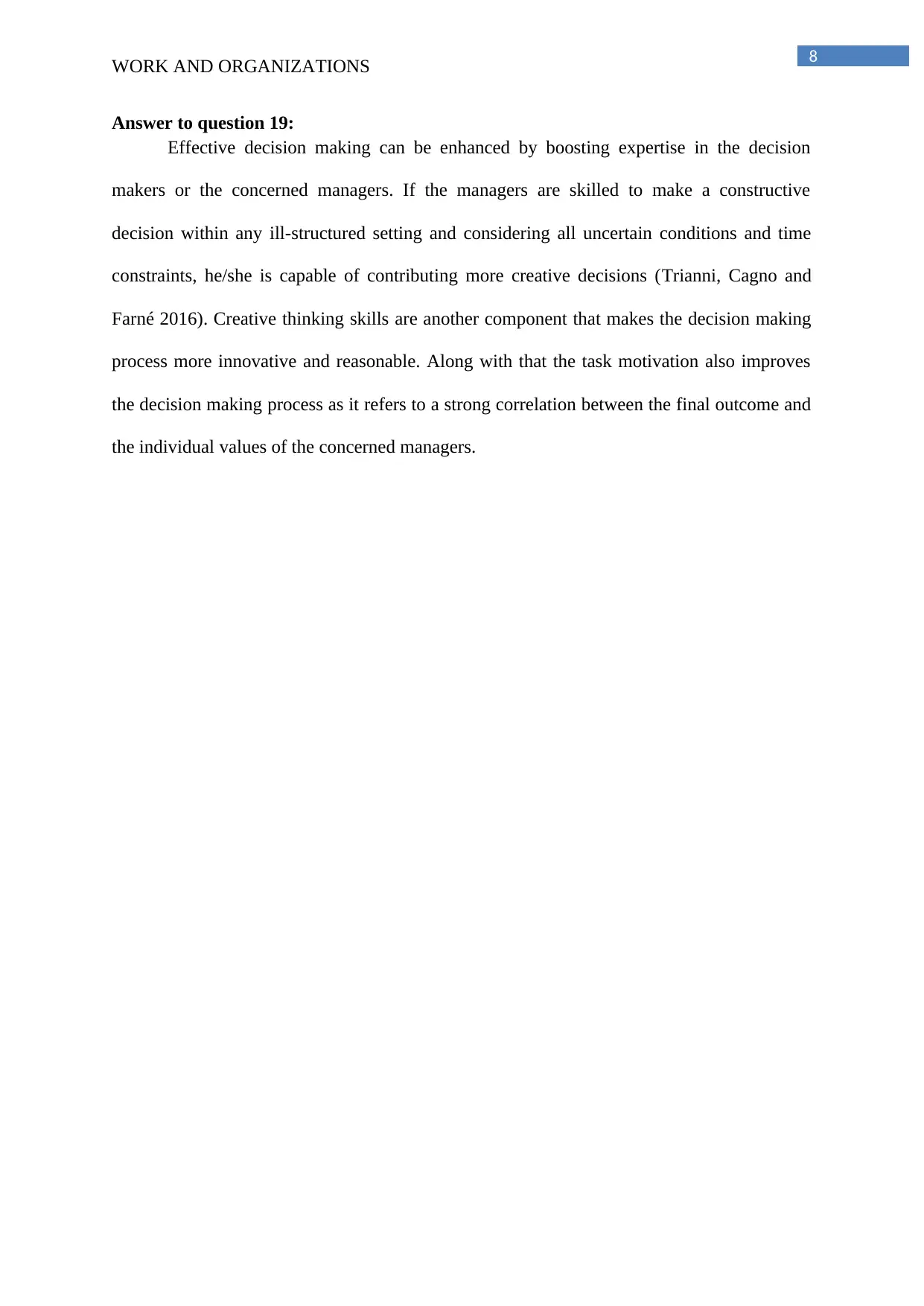
8
WORK AND ORGANIZATIONS
Answer to question 19:
Effective decision making can be enhanced by boosting expertise in the decision
makers or the concerned managers. If the managers are skilled to make a constructive
decision within any ill-structured setting and considering all uncertain conditions and time
constraints, he/she is capable of contributing more creative decisions (Trianni, Cagno and
Farné 2016). Creative thinking skills are another component that makes the decision making
process more innovative and reasonable. Along with that the task motivation also improves
the decision making process as it refers to a strong correlation between the final outcome and
the individual values of the concerned managers.
WORK AND ORGANIZATIONS
Answer to question 19:
Effective decision making can be enhanced by boosting expertise in the decision
makers or the concerned managers. If the managers are skilled to make a constructive
decision within any ill-structured setting and considering all uncertain conditions and time
constraints, he/she is capable of contributing more creative decisions (Trianni, Cagno and
Farné 2016). Creative thinking skills are another component that makes the decision making
process more innovative and reasonable. Along with that the task motivation also improves
the decision making process as it refers to a strong correlation between the final outcome and
the individual values of the concerned managers.
⊘ This is a preview!⊘
Do you want full access?
Subscribe today to unlock all pages.

Trusted by 1+ million students worldwide
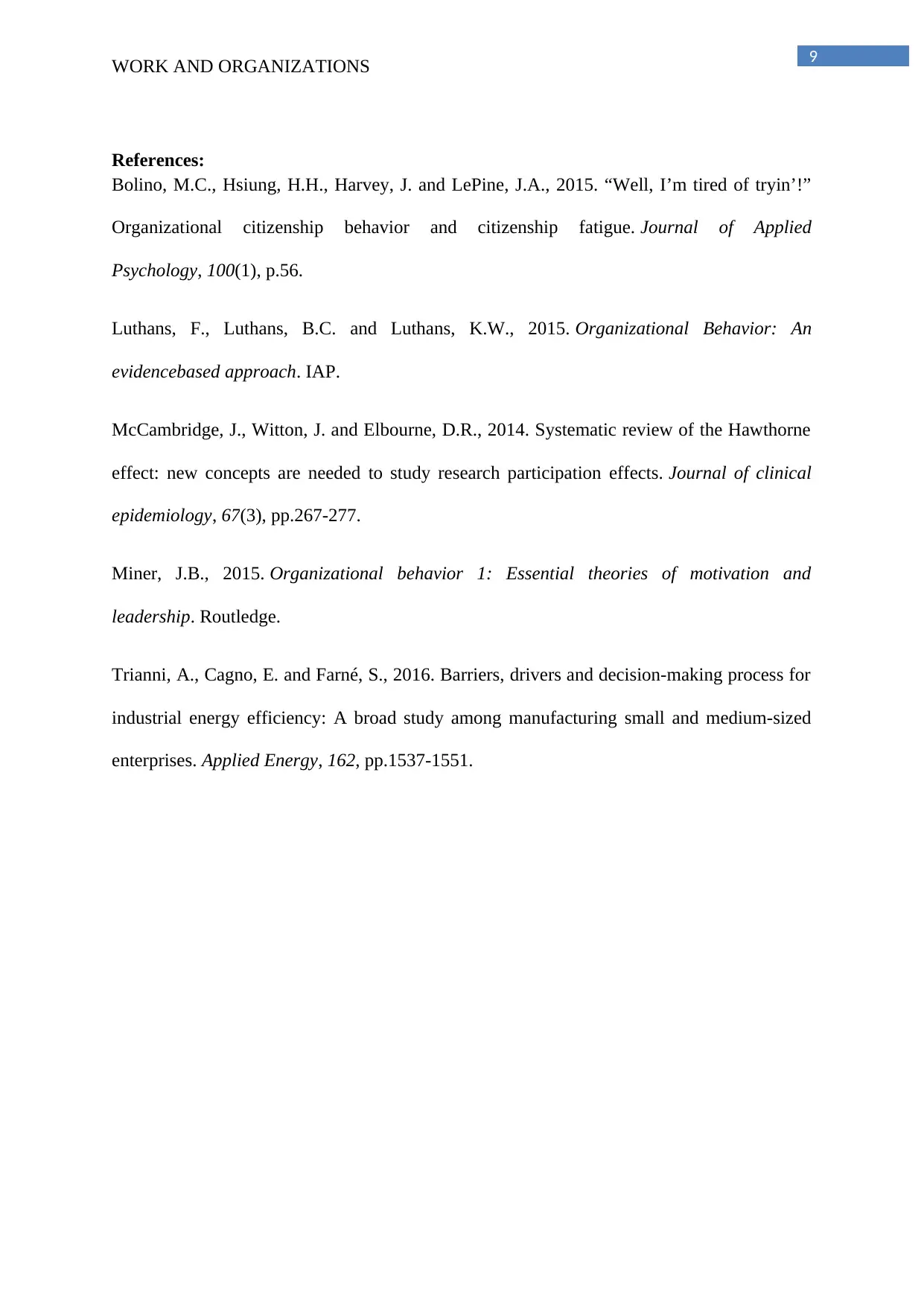
9
WORK AND ORGANIZATIONS
References:
Bolino, M.C., Hsiung, H.H., Harvey, J. and LePine, J.A., 2015. “Well, I’m tired of tryin’!”
Organizational citizenship behavior and citizenship fatigue. Journal of Applied
Psychology, 100(1), p.56.
Luthans, F., Luthans, B.C. and Luthans, K.W., 2015. Organizational Behavior: An
evidencebased approach. IAP.
McCambridge, J., Witton, J. and Elbourne, D.R., 2014. Systematic review of the Hawthorne
effect: new concepts are needed to study research participation effects. Journal of clinical
epidemiology, 67(3), pp.267-277.
Miner, J.B., 2015. Organizational behavior 1: Essential theories of motivation and
leadership. Routledge.
Trianni, A., Cagno, E. and Farné, S., 2016. Barriers, drivers and decision-making process for
industrial energy efficiency: A broad study among manufacturing small and medium-sized
enterprises. Applied Energy, 162, pp.1537-1551.
WORK AND ORGANIZATIONS
References:
Bolino, M.C., Hsiung, H.H., Harvey, J. and LePine, J.A., 2015. “Well, I’m tired of tryin’!”
Organizational citizenship behavior and citizenship fatigue. Journal of Applied
Psychology, 100(1), p.56.
Luthans, F., Luthans, B.C. and Luthans, K.W., 2015. Organizational Behavior: An
evidencebased approach. IAP.
McCambridge, J., Witton, J. and Elbourne, D.R., 2014. Systematic review of the Hawthorne
effect: new concepts are needed to study research participation effects. Journal of clinical
epidemiology, 67(3), pp.267-277.
Miner, J.B., 2015. Organizational behavior 1: Essential theories of motivation and
leadership. Routledge.
Trianni, A., Cagno, E. and Farné, S., 2016. Barriers, drivers and decision-making process for
industrial energy efficiency: A broad study among manufacturing small and medium-sized
enterprises. Applied Energy, 162, pp.1537-1551.
1 out of 10
Related Documents
Your All-in-One AI-Powered Toolkit for Academic Success.
+13062052269
info@desklib.com
Available 24*7 on WhatsApp / Email
![[object Object]](/_next/static/media/star-bottom.7253800d.svg)
Unlock your academic potential
Copyright © 2020–2025 A2Z Services. All Rights Reserved. Developed and managed by ZUCOL.





